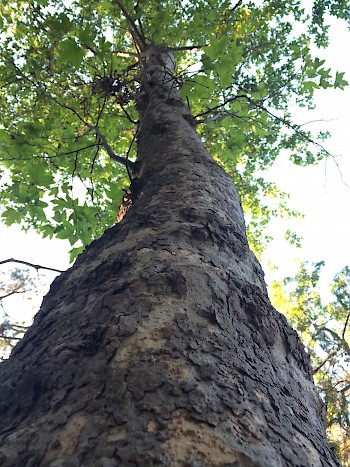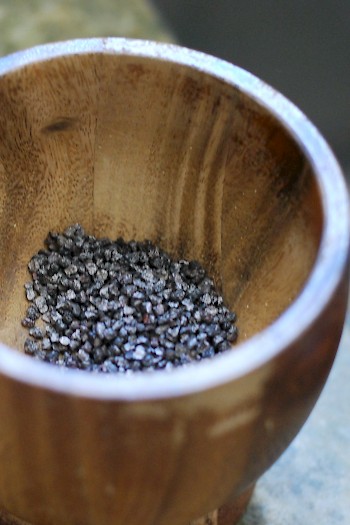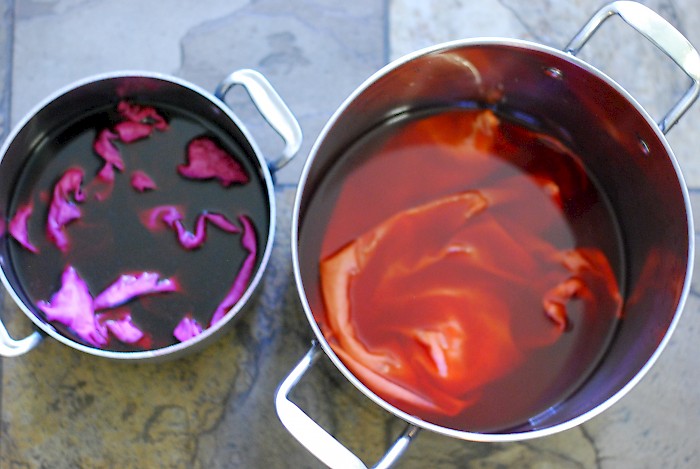April 19, 2016

Home
March Red
During the month of March, John Ronan chose to explore the color red for our natural dye experiments. Looking through the lists of potential plant materials that are available in our area, we stumbled on two that seemed practical.
Sycamore Dye
You know, (actually you probably don't know) I studied landscape architecture in my twenties, and learned to identify quite a range of plant material. Granted, I was living in Northern California then and the plants found there are wildly different from what is available in these southern parts. However, sycamore trees are pretty easy to guess at. When we pulled into the parking lot where John Ronan takes swimming, and I noticed that all the trees lining the creek there were of the sycamore variety, we rooted around in the fallen leaves together and picked up shed bark, plus we peeled some loose skin off of the trees as well. After our fantabulous success dyeing with eucalyptus, I was excited about getting a really wonderful red from the sycamore.



I would love for someone to look at my pictures here, and really tell me what tree bark I was dyeing with!
Because the red never came. A slight peachy color was boiled out of the bark, and then we added iron to half of the batch, just to see what in the world might happen, and a grey appeared. Once rinsed, we had two very pale but lovely napkins. I'm not complaining--they just weren't red.


Cochineal Dye
Cochineal is a reliable source of red. Also known as carmine, Natural Red 4, C.I. 75470 or E120, this natural dye is made by grinding up the dried insect (which makes its home on the prickly pear), and is used in all sorts of food stuff that you eat. If you're a vegetarian, and don't know about cochineal, you might want to do a quick search so you can avoid foods that contain this red dye. It's interesting, as I type, I'm aware that all of the dyes we've made so far have been from plant material. Probably because I didn't harvest these bugs myself, but instead pulled them out of a bottle, I didn't think much about the live bug that this dye comes from. But now... Now, I'm thinking. I don't even kill the spiders that come into our home. I name them, then cart them outside. I doubt I'll work with this dye again, despite the deep and lovely color that comes from it.



We simmered the ground cochineal, then split the batch, adding lemon juice to one pot. That pot turned orange.


We simmered the napkins in the dye for an hour or so, then let them cool. Because the colors were so vibrant, and vibrant colors are hard to come by in the natural world, we decided to split yet again the plain dye (the one without lemon juice) and add iron to see what might happen. Not surprisingly, we got purple.


But everything changed when we began rinsing the napkins in our ph neutral mix. They all devolved to pink--almost to the exact same pink. I'm wondering... if I had doubled the amount of cochineal used, perhaps we may have come a bit closer to red. I'm also wondering, if I had added some tannins, maybe the color of the mixes may have deepened... Hard to say. What we can say is--that we missnamed our month. Red was no where to be found.

But the year isn't over yet, friends. We're onto some wild experimenting in April and May, and I'm sure the results will be just as strange and unexpected as they've proved thus far.
Cheers, friends!
Published: April 19, 2016 | Filed under: Home








Well, Red natural or artificial dyes are not my daughters friend, but I'm sure you'll find a red at some point! What is the Greek red egg powder/dye for PASCHA made of???? Just wondering! Also, from now on, I shall also name the spiders, which I don't have many of, and then shoo them out, as I love spiders as long as they are not poisonous. Have a blessed PASCHA my dearest Jane! Love, Kh. Tammy
I'm not sure what the red dye mix is made of from Greece. Anyone else know? I do know that yellow onion skins do a pretty fine job at making a deep red. This blog post is a good one to show the results... http://www.illumination-learning.com/blog/2013/04/because-i-never-back-down-from-a-challenge/ Almost happy Pascha!